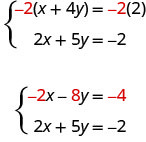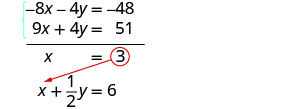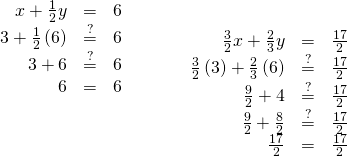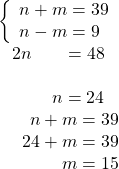4. Systems of Equations
4.3 Solve Systems of Equations by Elimination
Lynn Marecek and MaryAnne Anthony-Smith
Learning Objectives
By the end of this section it is expected that you will be able to:
- Solve a system of equations by elimination
- Solve applications of systems of equations by elimination
- Choose the most convenient method to solve a system of linear equations
We have solved systems of linear equations by graphing and by substitution. Graphing works well when the variable coefficients are small and the solution has integer values. Substitution works well when we can easily solve one equation for one of the variables and not have too many fractions in the resulting expression.
The third method of solving systems of linear equations is called the Elimination Method. When we solved a system by substitution, we started with two equations and two variables and reduced it to one equation with one variable. This is what we’ll do with the elimination method, too, but we’ll have a different way to get there.
Solve a System of Equations by Elimination
The Elimination Method is based on the Addition Property of Equality. The Addition Property of Equality says that when you add the same quantity to both sides of an equation, you still have equality. We will extend the Addition Property of Equality to say that when you add equal quantities to both sides of an equation, the results are equal.
For any expressions a, b, c, and d,

To solve a system of equations by elimination, we start with both equations in standard form. Then we decide which variable will be easiest to eliminate. How do we decide? We want to have the coefficients of one variable be opposites, so that we can add the equations together and eliminate that variable.
Notice how that works when we add these two equations together:

Let’s try another one:
This time we don’t see a variable that can be immediately eliminated if we add the equations.
But if we multiply the first equation by −2, we will make the coefficients of x opposites. We must multiply every term on both sides of the equation by −2.

Now we see that the coefficients of the x terms are opposites, so x will be eliminated when we add these two equations.
Add the equations yourself—the result should be −3y = −6. And that looks easy to solve, doesn’t it? Here is what it would look like.

We’ll do one more:
It doesn’t appear that we can get the coefficients of one variable to be opposites by multiplying one of the equations by a constant, unless we use fractions. So instead, we’ll have to multiply both equations by a constant.
We can make the coefficients of x be opposites if we multiply the first equation by 3 and the second by −4, so we get 12x and −12x.

This gives us these two new equations:
When we add these equations,

the x’s are eliminated and we just have −29y = 58.
Once we get an equation with just one variable, we solve it. Then we substitute that value into one of the original equations to solve for the remaining variable. And, as always, we check our answer to make sure it is a solution to both of the original equations.
Now we’ll see how to use elimination to solve the same system of equations we solved by graphing and by substitution.
EXAMPLE 1
Solve the system by elimination. ![]()







TRY IT 1
Solve the system by elimination. ![]()
Show answer
![]()
The steps are listed below for easy reference.
How to solve a system of equations by elimination.
- Write both equations in standard form. If any coefficients are fractions, clear them.
- Make the coefficients of one variable opposites.
- Decide which variable you will eliminate.
- Multiply one or both equations so that the coefficients of that variable are opposites.
- Add the equations resulting from Step 2 to eliminate one variable.
- Solve for the remaining variable.
- Substitute the solution from Step 4 into one of the original equations. Then solve for the other variable.
- Write the solution as an ordered pair.
- Check that the ordered pair is a solution to both original equations.
First we’ll do an example where we can eliminate one variable right away.
EXAMPLE 2
Solve the system by elimination. ![]()
 |
|
| Both equations are in standard form. | |
| The coefficients of y are already opposites. | |
| Add the two equations to eliminate y. The resulting equation has only 1 variable, x. |
 |
| Solve for x, the remaining variable. Substitute x = 11 into one of the original equations. |
 |
 |
|
| Solve for the other variable, y. |  |
| Write the solution as an ordered pair. | The ordered pair is (11, −1). |
| Check that the ordered pair is a solution to both original equations.  |
|
| The solution is (11, −1). |
TRY IT 2
Solve the system by elimination. ![]()
Show answer
![]()
In the next example, we will be able to make the coefficients of one variable opposites by multiplying one equation by a constant.
EXAMPLE 3
Solve the system by elimination. ![]()
 |
|
| Both equations are in standard form. | |
| None of the coefficients are opposites. | |
| We can make the coefficients of y opposites by multiplying the first equation by −3. |
 |
| Simplify. |  |
| Add the two equations to eliminate y. |  |
| Solve for the remaining variable, x. Substitute x = −4 into one of the original equations. |
 |
 |
|
| Solve for y. |    |
| Write the solution as an ordered pair. | The ordered pair is (−4, −5). |
| Check that the ordered pair is a solution to both original equations.  |
|
| The solution is (−4, −5). |
TRY IT 3
Solve the system by elimination. ![]()
Show answer
![]()
Now we’ll do an example where we need to multiply both equations by constants in order to make the coefficients of one variable opposites.
EXAMPLE 4
Solve the system by elimination. ![]()
In this example, we cannot multiply just one equation by any constant to get opposite coefficients. So we will strategically multiply both equations by a constant to get the opposites.
 |
|
| Both equations are in standard form. To get opposite coefficients of y, we will multiply the first equation by 2 and the second equation by 3. |
 |
| Simplify. |  |
| Add the two equations to eliminate y. |  |
| Solve for x. Substitute x = 0 into one of the original equations. |
 |
 |
|
| Solve for y. |  |
 |
|
| Write the solution as an ordered pair. | The ordered pair is (0, −3). |
| Check that the ordered pair is a solution to both original equations.  |
|
| The solution is (0, −3). |
What other constants could we have chosen to eliminate one of the variables? Would the solution be the same?
TRY IT 4
Solve the system by elimination. ![]()
Show answer
![]()
When the system of equations contains fractions, we will first clear the fractions by multiplying each equation by its LCD.
EXAMPLE 5
Solve the system by elimination. ![]()
In this example, both equations have fractions. Our first step will be to multiply each equation by its LCD to clear the fractions.
 |
|
| To clear the fractions, multiply each equation by its LCD. |  |
| Simplify. |  |
| Now we are ready to eliminate one of the variables. Notice that both equations are in standard form. |
|
| We can eliminate y multiplying the top equation by −4. |  |
| Simplify and add. Substitute x = 3 into one of the original equations. |
 |
| Solve for y. |  |
 |
|
 |
|
| Write the solution as an ordered pair. | The ordered pair is (3, 6). |
| Check that the ordered pair is a solution to both original equations.  |
|
| The solution is (3, 6). |
TRY IT 5
Solve the system by elimination. ![]()
Show answer
![]()
When we were solving systems of linear equations by graphing, we saw that not all systems of linear equations have a single ordered pair as a solution. When the two equations were really the same line, there were infinitely many solutions. We called that a consistent system. When the two equations described parallel lines, there was no solution. We called that an inconsistent system.
EXAMPLE 6
Solve the system by elimination:
a) ![]()
b) ![]()
c) ![]()
d)![]()
| a) | |
| Write the second equation in standard form. | |
| Clear the fractions by multiplying the second equation by 4. | |
| Simplify. | |
| To eliminate a variable, we multiply the second equation by Simplify and add. |
 |
| This is a true statement. The equations are consistent but dependent. Their graphs would be the same line. The system has infinitely many solutions. | |
| After we cleared the fractions in the second equation, did you notice that the two equations were the same? That means we have coincident lines. |
| b) |
|
| infinitely many solutions |
| c) | |
| infinitely many solutions |
| d) | |
| The equations are in standard form. | |
| Multiply the second equation by 3 to eliminate a variable. | |
| Simplify and add. |  |
| This statement is false. The equations are inconsistent and so their graphs would be parallel lines. | |
| The system does not have a solution. |
TRY IT 6
Solve the system by elimination. ![]()
Show answer
no solution
Solve Applications of Systems of Equations by Elimination
Some applications problems translate directly into equations in standard form, so we will use the elimination method to solve them. As before, we use our Problem Solving Strategy to help us stay focused and organized.
EXAMPLE 7
The sum of two numbers is 39. Their difference is 9. Find the numbers.
| Step 1. Read the problem. | |
| Step 2. Identify what we are looking for. | We are looking for two numbers. |
| Step 3. Name what we are looking for. Choose a variable to represent that quantity. |
Let |
| Step 4. Translate into a system of equations. The system is: |
The sum of two numbers is 39. Their difference is 9.  |
| Step 5. Solve the system of equations. To solve the system of equations, use elimination. The equations are in standard form and the coefficients of Solve for Substitute |
 |
| Step 6. Check the answer. | Since |
| Step 7. Answer the question. | The numbers are 24 and 15. |
TRY IT 7
The sum of two numbers is 42. Their difference is 8. Find the numbers.
Show answer
The numbers are 25 and 17.
EXAMPLE 8
Joe stops at a burger restaurant every day on his way to work. Monday he had one order of medium fries and two small sodas, which had a total of 620 calories. Tuesday he had two orders of medium fries and one small soda, for a total of 820 calories. How many calories are there in one order of medium fries? How many calories in one small soda?
| Step 1. Read the problem. | |
| Step 2. Identify what we are looking for. | We are looking for the number of calories in one order of medium fries and in one small soda. |
| Step 3. Name what we are looking for. | Let f = the number of calories in 1 order of medium fries. s = the number of calories in 1 small soda. |
| Step 4. Translate into a system of equations: | one medium fries and two small sodas had a total of 620 calories |
 |
|
| two medium fries and one small soda had a total of 820 calories. |
|
 |
|
| Our system is: |  |
| Step 5. Solve the system of equations. To solve the system of equations, use elimination. The equations are in standard form. To get opposite coefficients of f, multiply the top equation by −2. |
 |
| Simplify and add. |  |
| Solve for s. |  |
| Substitute s = 140 into one of the original equations and then solve for f. |
 |
 |
|
 |
|
 |
|
| Step 6. Check the answer. | Verify that these numbers make sense in the problem and that they are solutions to both equations. We leave this to you! |
| Step 7. Answer the question. | The small soda has 140 calories and the fries have 340 calories. |
TRY IT 8
Malik stops at the grocery store to buy a bag of diapers and 2 cans of formula. He spends a total of $37. The next week he stops and buys 2 bags of diapers and 5 cans of formula for a total of $87. How much does a bag of diapers cost? How much is one can of formula?
Show answer
The bag of diapers costs ?11 and the can of formula costs ?13.
Choose the Most Convenient Method to Solve a System of Linear Equations
When you will have to solve a system of linear equations in a later math class, you will usually not be told which method to use. You will need to make that decision yourself. So you’ll want to choose the method that is easiest to do and minimizes your chance of making mistakes.

EXAMPLE 9
For each system of linear equations decide whether it would be more convenient to solve it by substitution or elimination. Explain your answer.
a) ![]()
b) ![]()
Solution
a) ![]()
Since both equations are in standard form, using elimination will be most convenient.
b) ![]()
Since one equation is already solved for y, using substitution will be most convenient.
TRY IT 9
For each system of linear equations, decide whether it would be more convenient to solve it by substitution or elimination. Explain your answer.
a) ![]()
b) ![]()
Show answer
a) Since both equations are in standard form, using elimination will be most convenient.
b) Since one equation is already solved for ![]() , using substitution will be most convenient.
, using substitution will be most convenient.
Access these online resources for additional instruction and practice with solving systems of linear equations by elimination.
- Instructional Video-Solving Systems of Equations by Elimination
- Instructional Video-Solving by Elimination
- Instructional Video-Solving Systems by Elimination
Key Concepts
- To Solve a System of Equations by Elimination
- Write both equations in standard form. If any coefficients are fractions, clear them.
- Make the coefficients of one variable opposites.
- Decide which variable you will eliminate.
- Multiply one or both equations so that the coefficients of that variable are opposites.
- Add the equations resulting from Step 2 to eliminate one variable.
- Solve for the remaining variable.
- Substitute the solution from Step 4 into one of the original equations. Then solve for the other variable.
- Write the solution as an ordered pair.
- Check that the ordered pair is a solution to both original equations.
4.3 Exercise Set
In the following exercises, solve the systems of equations by elimination.
In the following exercises, translate to a system of equations and solve.
- The sum of two numbers is 65. Their difference is 25. Find the numbers.
- The sum of two numbers is −27. Their difference is −59. Find the numbers.
- Andrea is buying some new shirts and sweaters. She is able to buy 3 shirts and 2 sweaters for $114 or she is able to buy 2 shirts and 4 sweaters for $164. How much does a shirt cost? How much does a sweater cost?
- The total amount of sodium in 2 hot dogs and 3 cups of cottage cheese is 4720 mg. The total amount of sodium in 5 hot dogs and 2 cups of cottage cheese is 6300 mg. How much sodium is in a hot dog? How much sodium is in a cup of cottage cheese?
In the following exercises, decide whether it would be more convenient to solve the system of equations by substitution or elimination.
-
-
- Norris can row 3 miles upstream against the current in the same amount of time it takes him to row 5 miles downstream, with the current. Solve the system.

- for
 , his rowing speed in still water.
, his rowing speed in still water. - Then solve for
 , the speed of the river current.
, the speed of the river current.
- for
Answers:
- (6, 9)






- (6, 1)

- (2, 3)


- (9, 5)


- infinitely many solutions
- infinitely many solutions
- infinitely many solutions
- inconsistent, no solution
- inconsistent, no solution
- The numbers are 20 and 45.
- The numbers are 16 and −43.
- A shirt costs $16 and a sweater costs $33.
- There are 860 mg in a hot dog. There are 1,000 mg in a cup of cottage cheese.
-
- elimination
- substitution
-
- substitution
- elimination
-

